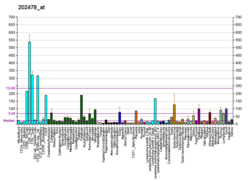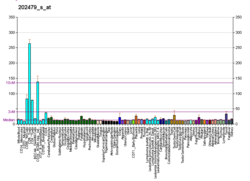
Summary
Tribbles homolog 2 is an atypical protein kinase that is encoded in human by the TRIB2 gene.[5][6][7][8] TRIB2 is a pseudokinase member of the (pseudoenzyme) class of signaling/scaffold proteins, possessing little vestigial catalytic output in vitro.[9] It is known to signal to canonical MAPK pathways and to regulate the ubiquitination of substrates with important functions in the immune system. It has also been associated with various diseases, especially in vertebrate leukaemia models.[10] Like TRIB1 and TRIB3, TRIB2 has recently been considered as a potential allosteric drug target,[11]
| TRIB2 | |||||||||||||||||||||||||||||||||||||||||||||||||||
|---|---|---|---|---|---|---|---|---|---|---|---|---|---|---|---|---|---|---|---|---|---|---|---|---|---|---|---|---|---|---|---|---|---|---|---|---|---|---|---|---|---|---|---|---|---|---|---|---|---|---|---|
| Identifiers | |||||||||||||||||||||||||||||||||||||||||||||||||||
| Aliases | TRIB2, C5FW, GS3955, TRB2, tribbles pseudokinase 2 | ||||||||||||||||||||||||||||||||||||||||||||||||||
| External IDs | OMIM: 609462 MGI: 2145021 HomoloGene: 41445 GeneCards: TRIB2 | ||||||||||||||||||||||||||||||||||||||||||||||||||
| |||||||||||||||||||||||||||||||||||||||||||||||||||
| |||||||||||||||||||||||||||||||||||||||||||||||||||
| |||||||||||||||||||||||||||||||||||||||||||||||||||
| |||||||||||||||||||||||||||||||||||||||||||||||||||
| |||||||||||||||||||||||||||||||||||||||||||||||||||
| Wikidata | |||||||||||||||||||||||||||||||||||||||||||||||||||
| |||||||||||||||||||||||||||||||||||||||||||||||||||
[12] and is a putative regulator of cancer-associated signalling and survival through AKT pSer473 modulation [13] High levels of autoantibodies against TRIB2 in Hcrt neurons (in lateral and posterior hypothalamus) seem also closely related to some cases of narcolepsy + cataplexy (N+C) [14]
References edit
- ^ a b c GRCh38: Ensembl release 89: ENSG00000071575 – Ensembl, May 2017
- ^ a b c GRCm38: Ensembl release 89: ENSMUSG00000020601 – Ensembl, May 2017
- ^ "Human PubMed Reference:". National Center for Biotechnology Information, U.S. National Library of Medicine.
- ^ "Mouse PubMed Reference:". National Center for Biotechnology Information, U.S. National Library of Medicine.
- ^ Wu M, Xu LG, Zhai Z, Shu HB (Jul 2003). "SINK is a p65-interacting negative regulator of NF-kappaB-dependent transcription". J Biol Chem. 278 (29): 27072–9. doi:10.1074/jbc.M209814200. PMID 12736262.
- ^ Keeshan K, He Y, Wouters BJ, Shestova O, Xu L, Sai H, Rodriguez CG, Maillard I, Tobias JW, Valk P, Carroll M, Aster JC, Delwel R, Pear WS (Nov 2006). "Tribbles homolog 2 inactivates C/EBPalpha and causes acute myelogenous leukemia". Cancer Cell. 10 (5): 401–11. doi:10.1016/j.ccr.2006.09.012. PMC 2839500. PMID 17097562.
- ^ Hegedus Z, Czibula A, Kiss-Toth E (Aug 2006). "Tribbles: novel regulators of cell function; evolutionary aspects". Cell Mol Life Sci. 63 (14): 1632–41. doi:10.1007/s00018-006-6007-9. PMID 16715410. S2CID 24556931.
- ^ "Entrez Gene: TRIB2 tribbles homolog 2 (Drosophila)".
- ^ Bailey FP, et al. (2015). "The Tribbles 2 (TRB2) pseudokinase binds to ATP and autophosphorylates in a metal-independent manner". Biochemical Society Transactions. 467 (1): 47–62. doi:10.1042/BJ20141441. PMC 4844368. PMID 25583260.
- ^ Eyers PA, Keeshan K, Kannan N (2016). "Tribbles in the 21st Century: The Evolving Roles of Tribbles Pseudokinases in Biology and Disease". Trends in Cell Biology. 27 (9): S0962-8924(16)30178-7. doi:10.1016/j.tcb.2016.11.002. PMC 5382568. PMID 27908682.
- ^ Foulkes DM, Byrne DP, Eyers PA (2015). "Tribbles pseudokinases: novel targets for chemical biology and drug discovery?". Biochemical Society Transactions. 43 (5): 1095–1103. doi:10.1042/BST20150109. PMID 26517930.
- ^ Byrne DP, Foulkes DM, Eyers PA (2017). "Pseudokinases: update on their functions and evaluation as new drug targets". Future Medicinal Chemistry. 9 (2): 245–265. doi:10.4155/fmc-2016-0207. PMID 28097887.
- ^ Hill R, Madureira PA, Ferreira B, Baptista I, Machado S, Colaço L, Dos Santos M, Liu N, Dopazo A, Ugurel S, Adrienn A, Kiss-Toth E, Isbilen M, Gure AO, Link W (2017). "TRIB2 confers resistance to anti-cancer therapy by activating the serine/threonine protein kinase AKT". Nature Communications. 8 (5): 14687. Bibcode:2017NatCo...814687H. doi:10.1038/ncomms14687. PMC 5347136. PMID 28276427.
- ^ Lim AS, Scammell TE (2010). "The trouble with tribbles: donantibodies against TRIB2 cause narcolepsy". Sleep. 33 (7): 857–8. doi:10.1093/sleep/33.7.857. PMC 2894423. PMID 20614841.
Further reading edit
- Strausberg RL, Feingold EA, Grouse LH, et al. (2003). "Generation and initial analysis of more than 15,000 full-length human and mouse cDNA sequences". Proc. Natl. Acad. Sci. U.S.A. 99 (26): 16899–903. Bibcode:2002PNAS...9916899M. doi:10.1073/pnas.242603899. PMC 139241. PMID 12477932.
- Kiss-Toth E, Bagstaff SM, Sung HY, et al. (2004). "Human tribbles, a protein family controlling mitogen-activated protein kinase cascades" (PDF). J. Biol. Chem. 279 (41): 42703–8. doi:10.1074/jbc.M407732200. PMID 15299019. S2CID 25829757.
- Gerhard DS, Wagner L, Feingold EA, et al. (2004). "The status, quality, and expansion of the NIH full-length cDNA project: the Mammalian Gene Collection (MGC)". Genome Res. 14 (10B): 2121–7. doi:10.1101/gr.2596504. PMC 528928. PMID 15489334.
- Hillier LW, Graves TA, Fulton RS, et al. (2005). "Generation and annotation of the DNA sequences of human chromosomes 2 and 4". Nature. 434 (7034): 724–31. Bibcode:2005Natur.434..724H. doi:10.1038/nature03466. PMID 15815621.
- Zhang Y, Davis JL, Li W (2005). "Identification of tribbles homolog 2 as an autoantigen in autoimmune uveitis by phage display". Mol. Immunol. 42 (11): 1275–81. doi:10.1016/j.molimm.2004.11.020. PMID 15950723.
- Lim J, Hao T, Shaw C, et al. (2006). "A protein-protein interaction network for human inherited ataxias and disorders of Purkinje cell degeneration". Cell. 125 (4): 801–14. doi:10.1016/j.cell.2006.03.032. PMID 16713569. S2CID 13709685.
- Lin KR, Lee SF, Hung CM, et al. (2007). "Survival factor withdrawal-induced apoptosis of TF-1 cells involves a TRB2-Mcl-1 axis-dependent pathway". J. Biol. Chem. 282 (30): 21962–72. doi:10.1074/jbc.M701663200. PMID 17545167.








